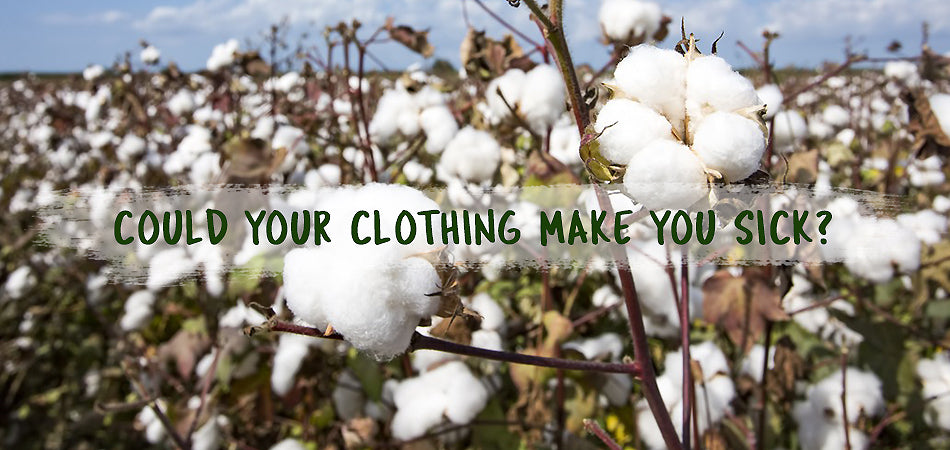As a committed eco-ethical fashion brand, we are always on the lookout for ways to improve the sustainability of our products. Over recent years, we have noticed many fashion labels using textiles made from recycled plastics, such as old fishing nets or water bottles.
Most of us probably know by now that synthetic textiles shed tiny plastic particles called microfibres when washed. These microscopic pieces of plastic end up in our waterways are ingested by our marine life, and in turn, are consumed by humans. The conclusion? Synthetic textiles are problematic from an environmental perspective. Which is why we prefer to use natural fibres such as certified organic cotton and hemp.
But could synthetic textiles also be harmful to your health? We decided to investigate both the potential health implications of synthetic textiles and the safety of fashion made from recycled plastic.
The short answer to our question was not definitive. But here’s what we discovered.
Crabs that consume microfibres suffer side effects.
As part of a study in 2015, crabs were fed food contaminated with microfibres. Those crabs then suffered side effects. They ate less food. Their growth was stunted, and their energy levels were depleted.
The plastic fibres consumed by the crabs also changed during the process of ingestion and excretion. The polypropylene broke down into smaller pieces, therefore increasing their surface area. The increased surface area means more plastic chemicals, such as Bisphenol A (BPA) can potentially leach into an animal’s tissues. Therefore, if humans accidentally consumed microfibres through seafood or contaminated water, BPA could leach into our bodies.
What is BPA?
Simply put, BPA is a chemical used to make plastic hard.
Back in 2012, the US Food and Drug Administration banned the sale of baby bottles made from BPA plastic because BPA can mimic oestrogen and disrupt the endocrine system. In fact, there are many endocrine-disrupting chemicals [EDCs] which do this, but for now, let’s focus on BPAs. “Animal and human research have associated BPA with many health problems including infertility, weight gain, behavioural changes, early-onset puberty, prostate and mammary gland cancers, cardiovascular effects, and diabetes.”
The primary source of BPA contamination in the human body seems to be through diet. While those BPA bottles have been banned, the chemical is still used in food packaging and as lining in the tins of canned food and drinks. As mentioned earlier, it can also enter our food chain through microfibre contaminated seafood and water.
BPA can also be absorbed through our skin by touching plastic toys and receipts, using liquid soaps and lotions packed in plastic bottles, through mattress foam and pillows, and through synthetic textiles. It’s so common that some studies suggest that up to 90% of Americans have traces of BPA in their blood. It’s worth noting at this point that scientists are still arguing over what level of BPA is considered harmful, and some even question whether BPS (the BPA replacement) is any safer than BPA.
Why would BPA exist in textiles?
Polyester is traditionally made from coal, air, water and petroleum which then undergoes a chemical reaction. These days, the process is different. Synthetic textiles are being made from recycled plastics which could contain BPA or other chemicals which could have the same endocrine-disrupting effects. Let us stress the word “could” in that last sentence. We don’t want to cause any panic and are supportive of businesses adopting a circular business model, but we do want to ask questions about the process.
It’s also interesting to consider the fact that plastic can only be recycled a certain number of times because it becomes weaker over time. Is it possible that a pair of pants made from recycled plastic is going to break down into smaller pieces, potentially contaminating our waterways, at a faster rate than the existing water bottle, or leach more chemicals in less time? Could recycling plastics into textiles be doing more harm than good?
At this point in time, we don’t believe there is any scientific proof that wearing synthetic textiles derived from recycled plastic is more damaging to your health than wearing synthetic textiles made from new plastic. But it’s definitely food for thought. Particularly since some research concluded that BPA absorbed through the skin is stored within the human body for longer than BPA which is eaten.
So what is the solution and where does that leave Etiko?
Take responsibility for what you already own.
If you already own synthetic textiles, like workout clothing or swimwear, ensure your wash the items in a Guppyfriend Bag (or similar) to avoid those microfibres entering our precious waterways. According to research conducted at the University of California, funded by Patagonia, a synthetic fleece jacket releases 1.7g of microfibres per wash. The older the garment, the more microfibres released. Wash it responsibly.
Choose natural fibres.
Synthetic fibres are resource intensive and not biodegradable. From an environmental perspective, they’re bad news. While we don’t have a definitive answer about the potential health risks of wearing plastics, you might wish to limit your contact. This is an entirely personal choice and we would encourage you to do your own research and develop your own conclusions.
As for Etiko?
We will continue to avoid using synthetic fibres in our clothing as much as possible and use certified organic natural fibres instead. For now, we won’t be using any new textiles made from plastic, but we will continue to work towards a circular business model by expanding our footwear take-back program into a recycling program for all Etiko products.
The health of our planet, its people and animals, is at the heart of our brand and every decision we make, which is why we say no to plastics.


Leave a comment